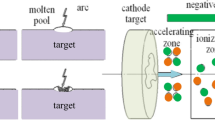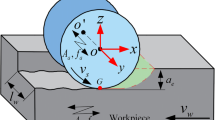Abstract
The current research of micro-grinding mainly focuses on the optimal processing technology for different materials. However, the material removal mechanism in micro-grinding is the base of achieving high quality processing surface. Therefore, a novel method for predicting surface roughness in micro-grinding of hard brittle materials considering micro-grinding tool grains protrusion topography is proposed in this paper. The differences of material removal mechanism between convention grinding process and micro-grinding process are analyzed. Topography characterization has been done on micro-grinding tools which are fabricated by electroplating. Models of grain density generation and grain interval are built, and new predicting model of micro-grinding surface roughness is developed. In order to verify the precision and application effect of the surface roughness prediction model proposed, a micro-grinding orthogonally experiment on soda-lime glass is designed and conducted. A series of micro-machining surfaces which are 78 nm to 0.98 μm roughness of brittle material is achieved. It is found that experimental roughness results and the predicting roughness data have an evident coincidence, and the component variable of describing the size effects in predicting model is calculated to be 1.5×107 by reverse method based on the experimental results. The proposed model builds a set of distribution to consider grains distribution densities in different protrusion heights. Finally, the characterization of micro-grinding tools which are used in the experiment has been done based on the distribution set. It is concluded that there is a significant coincidence between surface prediction data from the proposed model and measurements from experiment results. Therefore, the effectiveness of the model is demonstrated. This paper proposes a novel method for predicting surface roughness in micro-grinding of hard brittle materials considering micro-grinding tool grains protrusion topography, which would provide significant research theory and experimental reference of material removal mechanism in micro-grinding of soda-lime glass.
Similar content being viewed by others
References
DORNFELD D, MIN S, TAKEUCHI Y. Recent advances in mechanical micromachining[J]. Annals of the CIRP, 2006, 55(2): 745–768.
BRINKSMEIER E, GLABE R, OSMER J. Ultra-precision diamond cutting of steel molds[J]. Annals of the CIRP, 2006, 55(1): 551–554.
SCHALLER T, BOHN L, MAYER J, et al. Microstructure grooves with a width of less than 50 mm cut with ground hard metal micro-end mills[J]. Precision Engineering, 1999, 23: 229–235.
MORGAN C J, VALLANCE R R, MARSH E R. Specific grinding energy while microgrinding tungsten carbide with polycrystalline diamond micro tools[C/CD]//ICOMM-2007 2nd International Conference on Micro-Manufacturing, Sep 10 2007, Greenville, South Carolina, USA, No. 39.
AURICH J C, ENGMANN J, SCHUELER G M, et al. Micro grinding tool for manufacture of complex structures in brittle materials[J]. CIRP Annals-Manufacturing Technology, 2009, 58(1): 311–314.
ZHANG Bi, LIU X B, BROWN C. Microgrinding of nanostructured material coatings[J]. Annals of the CIRP, 2002, 51(1): 251–254.
SHUN T C, TSAI M Y, LAI Y C, et al. Development of a micro diamond grinding tool by compound process[J]. Journal of Materials Processing Technology, 2009, 209: 4 698–4 703.
CHENG Jun, GONG Yadong, WU Zhizheng, et al. Experimental study on mechanism of surface formation for micro-grinding of hard brittle material[J]. Chinese Journal of Mechanical Engineering, 2012, 48(21): 190–201. (in Chinese)
CHENG Jun, GONG Yadong. Experimental study on ductile-regime micro-grinding character of soda-lime glass with diamond tool[J]. International Journal of Advanced Manufacturing Technology, 2013, 10.1007/ s00170-013-5000-3.
WANG Jinsheng, GONG Yadong, ABBA G, et al. Chip formation analysis in micromilling operation[J]. International Journal of Advanced Manufacturing Technology, 2009, 45(5-6): 430.
XIE Jin, LU Yongxian. Study on axial-feed mirror finishgrinding of hard and brittle materials in relation to micron-scale grain protrusion parameters[J]. International Journal of Machine Tools and Manufacture, 2011, 51(1): 84–93.
ZHOU X, XI Feng. Modeling and predicting surface roughness of the grinding process[J]. International Journal of Machine Tools & Manufacture, 2002, 42(8): 969–977.
YAN Lan, RONG Yiming, JIANG Feng. Quantitive evaluation and modeling of alumina grinding wheel surface topography[J]. Chinese Journal of Mechanical Engineering, 2011, 47(17): 179–186. (in Chinese)
NGUYEN A T, BUTLER D L. Correlation of grinding wheel topography and grinding performance: A study from a viewpoint of three-dimensional surface characterisation[J]. Journal of Materious Processing Technology, 2008, 208(1–3): 14–23.
MALKIN S. Grinding technology theory and applications of machining with abrasives[M]. Society of Manufacturing Engineers, Dearborn, MI, USA. 2002.
HWANG T W, EVENS C J, MALKIN S. High speed grinding of silicon nitride with electroplated diamond wheels: part 1: wear and wheel life[J]. ASME Journal of Manufacturing Science and Engineering, 2000, 122: 32–41.
CHEN X, ROWE W B. Analysis and simulation of the grinding process, part 1: generation of the grinding wheel surface[J]. International Journal of Machine Tools & Manufacturing, 1996, 36(8): 871–882.
LAI Xinmin, LI Hongtao, LI Chengfeng, et al. Modeling and analysis of micro scale milling considering size effect, micro cutter edge radius and minimum chip thickness[J]. International Journal of Machine Tools & Manufacture, 2008, 48(1): 1–14.
Author information
Authors and Affiliations
Corresponding author
Additional information
This project is supported by National Natural Science Foundation for Young Scholars of China(Grant No. 51205053), and National Natural Science Foundation of China(Grant No. 51075064)
CHENG Jun, born in 1981, is currently an lecturer at Northeastern University, China. He received his PhD degree from Northeastern University, China, in 2011. His research interests include micro precision process, grinding mechanism.
GONG Yadong, born in 1958, is currently a professor and a PhD candidate supervisor at Northeastern University, China. His main research interests include grinding mechanism, digital manufacturing.
WANG Jinsheng, born in 1981, is currently a superviser of a diamond tool company. He received his PhD degree from Northeastern University, China, in 2009. His main research interests is micro precision machining.
Rights and permissions
About this article
Cite this article
Cheng, J., Gong, Y. & Wang, J. Modeling and evaluating of surface roughness prediction in micro-grinding on soda-lime glass considering tool characterization. Chin. J. Mech. Eng. 26, 1091–1100 (2013). https://doi.org/10.3901/CJME.2013.06.1091
Received:
Revised:
Accepted:
Published:
Issue Date:
DOI: https://doi.org/10.3901/CJME.2013.06.1091




